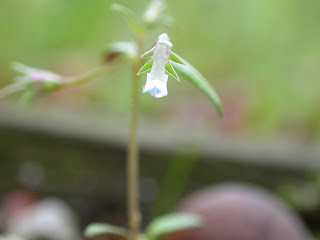The National Park Service and National Geographic Society joined forces this past weekend to hold a 24-hour BioBlitz at the Indiana Dunes National Lakeshore (to see a National Geographic account of the event, click here). I participated by leading survey teams at Miller Woods Pannes, Howe's Prairie, and Inland Marsh. My teams tallied over 200 plant species at these sites during our field trips. However, my most exciting find came at my campsite at the Indiana Dunes National Lakeshore campground.
In April 2005, Keith found Collinsia sparsiflora, a species native to the extreme western United States and never before seen in Indiana or the Chicago Region, at the horsemen's campground at Potato Creek State Park.
 Soon after Keith's observation, the campsites were herbicided by the park, and this plant hasn't been seen at this location since.
Soon after Keith's observation, the campsites were herbicided by the park, and this plant hasn't been seen at this location since. On Friday, I spotted what I believe to be Collinsia parviflora, a species native to the western United States, Canada, and scattered counties in the northeastern United States, growing in gravel at my campsite.
 Until now (if my identification is confirmed), this species was not known from Indiana or the Chicago Region. The closest known population of maiden blue-eyed Mary to northwest Indiana is in the Upper Peninsula of Michigan. At my campsite, there were several individuals of Collinsia parviflora, so I made a collection in addition to taking photographs.
Until now (if my identification is confirmed), this species was not known from Indiana or the Chicago Region. The closest known population of maiden blue-eyed Mary to northwest Indiana is in the Upper Peninsula of Michigan. At my campsite, there were several individuals of Collinsia parviflora, so I made a collection in addition to taking photographs.
My campsite was chosen for me by someone from the National Park Service... I guess they picked the "right place" for me to stay.


Now for the "right time" part... I found this plant when botanizing my campsite by lantern with Maryland botanist Joe Metzger, who was sharing the campsite with me, at approximately 9:00 PM CDT, in the dark. Who says that the only good botanizing takes place during the day? I guess I take this 24-hour BioBlitz thing pretty literally!

Tidak ada komentar:
Posting Komentar